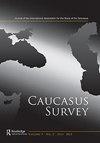亚美尼亚移民到北美的政治,1885-1915:旅居者、走私者和可疑公民
IF 0.5
Q3 AREA STUDIES
引用次数: 2
摘要
我们这个时代最显著的现象之一是,由于战争、迫害和贫困,人们离开家园到其他地方定居的流动率很高。根据联合国的估计,2019年全球国际移民人数达到2.72亿。9.1由于各国为了“国家利益”试图阻止他们的流动,其中许多人在途中死亡。各国决定哪些人的流动是合法的,哪些是非法的。尽管其规模和悲剧已经达到了惊人的程度,但从东方到西方的全球移民并不是一个新现象。大卫·古特曼(David Gutman)的《亚美尼亚移民到北美的政治》(The Politics of Armenian Migration to North America,1885–1915):记者、走私者和可疑公民处理了最早的案件之一,即奥斯曼亚美尼亚人移民到美国。正如古特曼所说,当时中东移民和难民的高流动性重塑了国家阻止他们的政策和方法,在接下来的几十年里,大多数都成为了公认的做法。古特曼的工作为评估现代移民制度和实践是如何形成的开辟了一个视角。他正确地抱怨了研究移民这一当代全球现象的学者(我们可以加上活动家)与该主题的历史学家之间缺乏对话(第45页)。他的作品可以被解读为试图开始这样一场对话,这将加深对全球移民动态的理解。作者计算,从19世纪80年代末到19世纪10年代,至少有65000名亚美尼亚人从奥斯曼帝国迁移到北美(第4页)。他将重点放在东部的哈普特地区,因为这些亚美尼亚人中有一半以上来自该地区。经过精辟的介绍,这本书分为三个部分。第一部分由三章组成,论述亚美尼亚人的出境移民问题。它讲述了哈普特地区移民的历史,并解释了奥斯曼帝国如何以及为什么试图阻止亚美尼亚人向北美移民,以及为什么失败,以及走私网络在禁令后是如何出现和运作的。第二部分由第4章和第5章组成,重点介绍亚美尼亚人的返回移民以及奥斯曼帝国阻止他们入境的努力。N E W P E R S P E C T IV E S O N T U R K E Y本文章由计算机程序翻译,如有差异,请以英文原文为准。
The politics of Armenian migration to North America, 1885–1915: sojourners, smugglers, and dubious citizens
One of the most distinctive phenomena of our era is the high rate of mobility of people who leave their home to settle somewhere else because of war, persecution, poverty. According to UN estimate, the number of international migrants globally reached 272 million in 2019.1 Many of them die on their way as states try to block their movement for the sake of “national interests.” States decide which movements of human beings are legal which are not. Although its scale and tragedy have reached a stunning level, global migration from East to West is hardly a new phenomenon. David Gutman’s The Politics of Armenian Migration to North America, 1885–1915: Sojourners, Smugglers and Dubious Citizens handles one of the earliest cases, namely migration of Ottoman Armenians to the US. As Gutman argues, the high mobility of Middle Eastern immigrants and refugees of the time in question reshaped the policies and methods of states to deter them, most of which became well-established practices in the following decades. Gutman’s work opens up a perspective to assess how the modern regime and practices of migration have been shaped. He rightly complains about a lack of conversation between scholars (we may add activists) who study migration as a contemporary global phenomenon and historians of the subject (p. 45). His work may be read as an attempt at starting such a conversation, which would sharpen the understanding of the dynamics of global migration. The author calculates that at least 65,000 Armenians migrated from the Ottoman Empire to North America from the late 1880s to the 1910s (p. 4). He focuses on the Harput region in the east, as more than half of those Armenians were from this region. After a capable introduction, the book is divided into three parts. The first part, consisting of three chapters, handles the outbound migration of Armenians. It narrates the history of migration from the Harput region, and explains how and why the Ottoman state tried to halt the migration of Armenians to North America and why it failed, as well as how the smuggling networks emerged and worked after the ban. The second part, consisting of chapters 4 and 5, focuses on the return migration of Armenians and the efforts of the Ottoman state to block their entrance. N E W P E R S P E C T IV E S O N T U R K E Y
求助全文
通过发布文献求助,成功后即可免费获取论文全文。
去求助
来源期刊

Caucasus Survey
Arts and Humanities-History
CiteScore
1.30
自引率
9.10%
发文量
4
期刊介绍:
Caucasus Survey is a new peer-reviewed, multidisciplinary and independent journal, concerned with the study of the Caucasus – the independent republics of Armenia, Azerbaijan and Georgia, de facto entities in the area and the North Caucasian republics and regions of the Russian Federation. Also covered are issues relating to the Republic of Kalmykia, Crimea, the Cossacks, Nogays, and Caucasian diasporas. Caucasus Survey aims to advance an area studies tradition in the humanities and social sciences about and from the Caucasus, connecting this tradition with core disciplinary concerns in the fields of history, political science, sociology, anthropology, cultural and religious studies, economics, political geography and demography, security, war and peace studies, and social psychology. Research enhancing understanding of the region’s conflicts and relations between the Russian Federation and the Caucasus, internationally and domestically with regard to the North Caucasus, features high in our concerns.
 求助内容:
求助内容: 应助结果提醒方式:
应助结果提醒方式:


